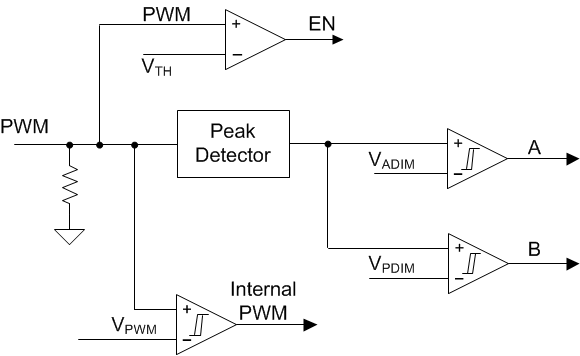SLUSCO8B November 2016 – June 2018 TPS54200 , TPS54201
PRODUCTION DATA.
- 1 Features
- 2 Applications
- 3 Description
- 4 Revision History
- 5 Description (continued)
- 6 Pin Configuration and Functions
- 7 Specifications
-
8 Detailed Description
- 8.1 Overview
- 8.2 Functional Block Diagram
- 8.3 Feature Description
- 8.4 Device Functional Modes
- 9 Application and Implementation
- 10Power Supply Recommendations
- 11Layout
- 12Device and Documentation Support
- 13Mechanical, Packaging, and Orderable Information
Package Options
Mechanical Data (Package|Pins)
- DDC|6
Thermal pad, mechanical data (Package|Pins)
Orderable Information
8.4.2 Mode Detection
The magnitude of the PWM signal is used to determine which dimming mode the device enters. The internal peak detector at the PWM pin holds the magnitude of the PWM signal. Once the device is enabled, after 300-µs delay, the output of the peak detector is compared with two voltage thresholds, VADIM and VPDIM, which are 1 V and 2.07 V, respectively. If the output of the peak detector is higher than 2.07 V, analog dimming mode is chosen and locked. If the output is between 1 V and 2.07 V, PWM dimming mode is chosen and locked. If the output is less than 1 V, the device waits another 300 µs and compares again, and this process repeats until at least one mode is chosen and locked. See Figure 17 and Table 1 for reference. After the mode is detected and locked, soft start begins, the output voltage ramps up, and the LED current is regulated at the target value. The dimming mode cannot be changed unless VIN or PWM is cycled. section
 Figure 17. Mode Detection Circuit
Figure 17. Mode Detection Circuit
Table 1. Mode Detection Condition
| A | B | MODE |
|---|---|---|
| H | H | Enter analog dimming mode |
| L | H | Enter PWM dimming mode |
| L | L | Keep detecting until one dimming mode is locked |